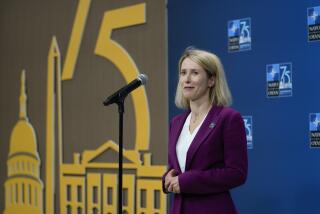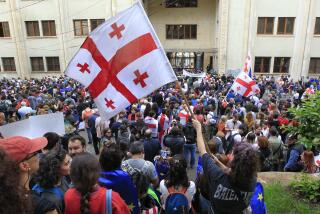Ex-Soviet State Dares to Dream
- Share via
NARVA, Estonia — A few months after Estonia won independence from the Soviet Union in 1991, the people of this historic border town held a referendum to secede from their new country and reunite with Russia.
Fortunately for the town, the attempt failed, and today residents are trying to forget it ever happened. As Narva’s prosperity rises with the rest of capitalist Estonia, the townsfolk can look across the Narva River to the seedy Russian town of Ivangorod and see the dismal life they escaped.
In Narva, new private businesses have sprung up. Tidy rows of flowers are planted along the main streets. People drive cars made in Western Europe and shop at a modern supermarket that could just as easily be in Santa Monica.
“If that referendum were held today, people would never want to join Russia,” said Narva town council member Svetlana Legkodym. “The West is open for us now. The East is practically closed.”
Across the border in Ivangorod, dilapidated Soviet-era buildings are set among weeds and potholed streets. Apartments have no hot water; some have no water at all. Too poor to process its sewage, the town dumps it untreated into the river. At the local outdoor market, desperate pensioners try to make a few rubles by selling cabbage and carrots from their gardens.
These days, it is Ivangorod’s turn to dream of a different future. Last year, the town sent a petition to President Boris N. Yeltsin seeking to secede from Russia and become part of Estonia, where ethnic Russians make up a third of the population. Yeltsin ignored the request.
“I wish I could hang myself,” said Alexander Lipski, a 64-year-old Ivangorod engineer who gets a monthly pension worth $15 and picks wild chervil to sell at the market. “Thirty-eight years of work, and this is all I have.”
Over the past eight years, Russia and Estonia have both claimed to have enacted “reforms,” but only Estonia has succeeded in transforming its economy and markedly improving the lives of its people.
After winning its independence, the tiny Baltic nation set out to erase the legacy of Soviet occupation by adopting a radical sink-or-swim economic program. Drawing inspiration from the likes of conservative former British Prime Minister Margaret Thatcher and U.S. free-market economist Milton Friedman, the government eliminated trade tariffs, embraced foreign investment, adopted a flat income tax, privatized most state holdings and boldly tied its currency to the German mark.
Estonia also created a free-trade zone where its own factories were forced to compete on the world market without the benefit of government subsidies. Today, Estonia--smaller than San Bernardino County--is the most successful of the 15 countries that once made up the Soviet Union.
“Compared to Russia, Estonia is like an Eskimo’s kayak,” Estonian President Lennart Meri likes to say. “A supertanker needs 16 nautical miles to reverse course. An Eskimo can do it on the spot.”
Occupying a strategic position on the Baltic Sea, Estonia has been at the center of conflict between East and West for much of the past millennium. Danes, Teutonic Knights, Swedes, Russians and Germans have all fought to control it.
Conquered by Peter the Great in 1710, Estonia declared independence from Russia in 1918. Overrun by both the Nazis and the Communists during World War II, it finally ended up under Soviet control in 1944.
Country Hopes to Join EU, NATO
Today, government policy is driven by the fear that sooner or later Russia will grow strong enough to seize it again. Recognizing that it has little chance of surviving on its own, the country of 1.4 million people has sought to integrate its economy with Western Europe and enter the European Union. It also hopes to secure its protection by winning admission to the North Atlantic Treaty Organization.
Estonia shares a similar history of occupation with its neighboring Baltic republics, Latvia and Lithuania. The other two nations have trailed Estonia in their efforts at economic reconstruction but also have staked their future on joining the European Union and NATO.
Turning its back on Russia, Estonia has attracted $1.5 billion in Western foreign investment--much of it to convert factories to make goods for the European market. Since 1992, the share of products Estonia exports to Russia has plummeted from 85% to 8%.
While Russia perennially begs for more foreign loans, Estonia stunned the World Bank in 1997 by offering to start repaying its loans before they were due. While Russia’s national debt equals nearly 90% of its gross domestic product, Estonia’s debt is just 4% of its GDP.
One of Estonia’s most visible successes is the Old Town of Tallinn, the nation’s capital, where renovated historic buildings, cobblestone streets and shops brimming with goods attract millions of tourists a year. Despite the ravages of war and Soviet occupation, it is one of the best-preserved medieval city centers in Europe.
Tiny Baltic Nation Becoming Wired
Modern technology has arrived in a rush, and Estonia boasts higher rates of mobile phone and Internet use than many other European countries. The government has launched a drive to connect every classroom to the Internet by 2000; already, 64% of Estonia’s schools are online. Prime Minister Mart Laar also has begun creating what he calls a “virtual government” to provide information and services through the Internet.
“There is one advantage in starting late,” said Laar, 39, who is credited with spearheading the economic transformation of the early 1990s. “You can see the mistakes of what was done before you. If your economy was destroyed, you can have a very modern economy like what we are building now.”
Even so, Estonia’s efforts to detach itself from its giant neighbor were not enough to shield it from the effects of Russia’s economic collapse a year ago.
Food products--one of the last big export items to Russia--dropped sharply with Moscow’s devaluation of the ruble. Tallinn bankers suffered significant losses, and some of the biggest banks were forced to merge. The combination triggered a recession. The economy, which grew 11% in 1997, began shrinking at the end of 1998 and has yet to recover. The government was forced to cut its budget by more than 5% and is still running a deficit.
Analysts, however, predict that Estonia will start pulling out of its slump by the end of the year.
“Technically, we have a recession in growth,” President Meri said. “Of course, this is nothing to be happy about, but it is not a crisis. The gut feeling of most businessmen is that we have passed that point and the economy is picking up.”
With the end of the Soviet Union, Estonians reasserted their national identity at the expense of the country’s Russian-speaking minority. Viewing ethnic Russians as part of a Soviet occupation force, the government denied citizenship even to those born in Estonia after 1940 unless they could pass a civics test in Estonian--a difficult language most ethnic Russians never bothered to learn.
Ethnic Russians also were hit hard by the restructuring of the economy. Under communism, they often had the best jobs and the best apartments. But now, without state subsidies, the factories where they worked have shut down. Many complain that the government discriminates against them.
Russia has been highly critical of Estonia’s treatment of Russians, and Moscow’s policies have widened the gulf between the two countries. Russia, for example, has imposed a double tariff on all imports from Estonia.
Russia also has never acknowledged the Soviet occupation of Estonia--instead maintaining the old line that the Communists were assisting the fraternal peoples of the Baltics. Precious symbols of Estonian independence--a gold medal and sash worn by Estonia’s president that were seized by Soviet soldiers in 1940--still sit on display in a Kremlin museum. Russia has no plans to return them.
Estonians, who once crossed the border freely, now must get a visa to enter Russia. Few make the trip, and young Estonians form their view of Russia from American movies. Youngsters refuse to learn Russian, and English is increasingly becoming Estonia’s second language.
Relatives Live Across River in Russia
At Estonia’s northeastern border, the two countries are separated by the Narva River, a historic dividing line between East and West. Two fortresses face each other across the river: one begun by Czar Ivan III in 1492 in the town that bears his name, and the other in Narva in the 13th century by Danes trying to hold back the Russians.
During Soviet times, Ivangorod and Narva functioned as one town and shared municipal services. Most residents came from Russia and other Soviet republics such as Belarus and Ukraine. Today, only 6% of Narva’s 75,000 residents are Estonian, and many have relatives living on the other side of the river.
Across the river, life is bleak for Ivangorod’s 12,000 residents.
“People don’t have anything,” said Irina Voltchek, 35, the mayor’s press secretary. “They don’t receive wages--even late. There are no jobs, no work. Almost no one believes in the future.”
Voltchek said the heart of the town’s business activity is its market--a dismal collection of wooden stalls with a small assortment of food, cheap imported goods and pirated videos for sale.
Pensioners can rent a stall for 1 ruble--about 4 cents--and sell vegetables from their gardens. The more ambitious cross into Narva and bring back European products to sell.
“Everything is dead in Ivangorod,” said Lyubov Vykhodina, 45, a former librarian who sells inexpensive soap and packaged food she buys in Narva. “This market is the only living place.”
At a nearby stall, Bronislava Eremitskaya, 65, was trying to supplement her $16.50 monthly pension by selling the three cabbages, four squash and seven carrots she had grown. Asked how life was in Ivangorod, she started to cry. “If life was good,” she said, “I wouldn’t be here.”
In Narva, the recession has been harsher than elsewhere in Estonia. Unemployment is 16%--triple the national rate. Pensioners line up for hours at the border to cross into Ivangorod and buy Russian foodstuffs at prices made much cheaper by the ruble’s devaluation.
Despite the hardships, however, Narva’s ethnic Russians know they are lucky to be living in Estonia. For one, wages and pensions are many times higher in Narva--and they are paid on time.
“We are better off here,” construction worker Vladimir Orlov, 47, said as he looked across the river at Ivangorod. “There is order here. The city is clean. You feel sure about your future.”
More to Read
Sign up for Essential California
The most important California stories and recommendations in your inbox every morning.
You may occasionally receive promotional content from the Los Angeles Times.













